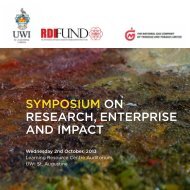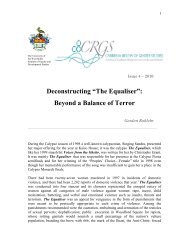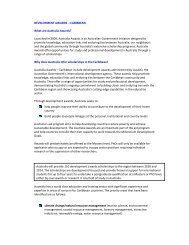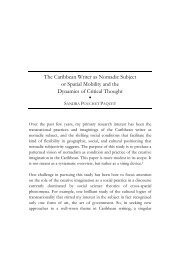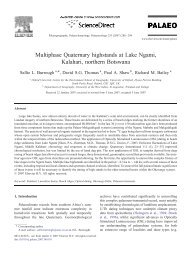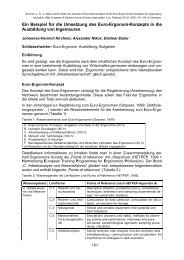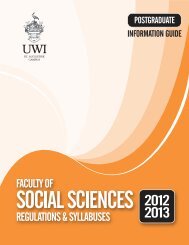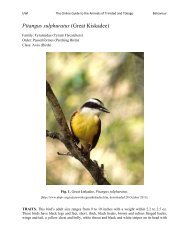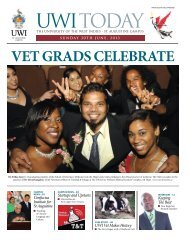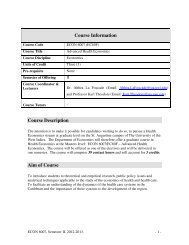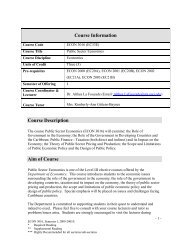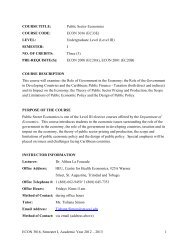Falco peregrinus (Peregrine Falcon)
Falco peregrinus (Peregrine Falcon)
Falco peregrinus (Peregrine Falcon)
Create successful ePaper yourself
Turn your PDF publications into a flip-book with our unique Google optimized e-Paper software.
UWI The Online Guide to the Animals of Trinidad and Tobago Behaviour<br />
<strong>Falco</strong> <strong>peregrinus</strong> (<strong>Peregrine</strong> <strong>Falco</strong>n)<br />
Family: <strong>Falco</strong>nidae (<strong>Falco</strong>ns)<br />
Order: <strong>Falco</strong>niformes (Diurnal Birds of Prey)<br />
Class: Aves (Birds)<br />
Fig. 1. <strong>Peregrine</strong> falcon, <strong>Falco</strong> <strong>peregrinus</strong>.<br />
[http://gardenofeaden.blogspot.com/2012/09/the-peregrine-falcon.html, downloaded 1 November 2012]<br />
TRAITS. The peregrine falcon (<strong>Falco</strong> <strong>peregrinus</strong>) is a medium sized raptor which has a body<br />
length of 13-23 inches and a wing span of 29-47 inches. The females are substantially larger than<br />
the males (on average by 30 %) and they weight 2.0-3.3 pounds while the males weigh a mere<br />
0.9-1.7 pounds (Ratcliffe, 1993). The falcon has long pointed wings which are slate grey in<br />
colour (Fig.1). The slate grey also continue to the back and crown of the falcon, however the<br />
under body is white with bands of dark brown or black present. The rings around the eyes are<br />
bluish in colour and the feet are yellow. The beak and claws are black and the beak shows a<br />
characteristic notch which allows them to sever the spinal column of the prey (Blood, 2001).<br />
The juveniles differ from the adults in that they are much browner and their beaks are bluish in
UWI The Online Guide to the Animals of Trinidad and Tobago Behaviour<br />
colour. The name <strong>Falco</strong> <strong>peregrinus</strong> means wandering falcon and this is due to the migratory<br />
behaviour some display. This falcon is also known by its local name duck hawk in North<br />
America.<br />
It is a regular migratory winter visitor to both Trinidad and Tobago.<br />
ECOLOGY. The peregrine falcon has a large range of habitats which includes wetlands, water<br />
ways, estuaries, barrier beaches, offshore islands, coastal beaches etc. In essence the peregrine<br />
falcons are globally distributed and they tend to be found in open habitats and can live in<br />
altitudes up to twelve thousand feet. They construct their nest on the ledges of steep remote<br />
cliffs and they do this by using their feet and claws to scratch a hole in the soil (Fig. 2). In<br />
addition in more urban environments the falcon constructs their nest on skyscrapers. In some<br />
cases the peregrine falcon may not construct their own nest however they may even steal the<br />
nest of another cliff resting bird (Ratcliffe, 1993).The falcons prefer open habitats since this<br />
complements their hunting behavior. Some groups of the falcon migrate over large distances in<br />
the winter months and the peregrine falcon inhabits every continent except that of Antarctica.<br />
The falcon diet consists of birds as well as small mammals such as rats and shrews and reptiles<br />
(Ratcliffe, 1993). It is considered an apex predator and it acts as a check and balance of prey<br />
populations<br />
in the ecosystem.<br />
SOCIAL ORGANIZATION. <strong>Peregrine</strong> falcon leads a fairly solitary life. They hunt by<br />
themselves and hunt moderate sized birds. They construct their nest high on steep cliffs or even<br />
skyscrapers. If the nest is abandoned it may be used by another peregrine. The social<br />
organization depends on whether the falcon is one that exhibits migratory tendencies or if the<br />
falcon is one that is sedentary. <strong>Peregrine</strong> falcons mate with one mate for their lifetime (i.e. they<br />
are monogamous), they live in the same nest and in migratory falcons after mating season is over<br />
and the young birds learn to fly the juveniles migrate south wards during the winter months with<br />
their parents to find a suitable home (Montana field guide, 2012). It should be noted that once the<br />
birds are mated the male goes out and looks for the food which he brings home for the female. In<br />
sedentary peregrine falcons such as those in Barcelona the pairs of falcons stick close to each<br />
other during<br />
breeding season however the birds tend not to stray far even outside of breeding<br />
season.<br />
ACTIVITY. The peregrine falcon hunts at periods when the prey is most active. As such they<br />
hunt mainly at dawn and dusk, however some of the falcons show nocturnal activity which<br />
comes about due to the migratory behaviour. The falcon feeds mainly on medium sized birds<br />
such as doves, song birds and water fowl. They stalk their prey from high altitudes and then dive<br />
at speeds of up to 200 miles/hr and grab their prey (Cade, 1982). The peregrine falcon hunts best<br />
in open spaces (e.g. open water or marshes) and thus tends to live on steep rock surfaces where<br />
they can see their prey from far and also because<br />
it in inaccessible for animals to access their<br />
clutch<br />
of eggs when they are away hunting.<br />
FORAGING BEHAVIOUR. The peregrine falcon feeds mainly at dawn and dusk when prey<br />
are most active. They hunt their prey, usually birds, using a number of strategies to sight, attack<br />
and to kill their prey. The falcon uses its speed as a major tactical advantage. One of the major<br />
foraging techniques includes stalking their prey from high altitudes and upon seeing a potential<br />
target they plunge down at speeds up to 200 miles/hr and grab the prey using their talons on their<br />
feet and using its notch beak it breaks the prey’s spine (Cade, 1982). The falcon sets down at its
UWI The Online Guide to the Animals of Trinidad and Tobago Behaviour<br />
nest or in a safe place and dissects the bird, first removing the feathers and gut (Fig. 3). The<br />
peregrine falcon’s preferred diet of birds includes columbiform birds such as doves and pigeons<br />
however it has also been observed that the falcon may also hunt small mammals (e.g. rats) and<br />
small<br />
reptiles too (e.g. small snakes), (Ratcliffe, 1993).<br />
COMMUNICATION. <strong>Peregrine</strong> falcon uses vocal as well as physical communication. The<br />
falcon uses vocal communication for a number of reasons. The majority of vocal communication<br />
between the falcons is within the breeding season. Most of the other year round vocal<br />
communication is mainly between parents and offspring or mate and sometimes antagonistic. For<br />
instance “cack” calls are those used by the falcon in order to produce an alarm. These calls are<br />
very specific to particular individuals with individual recognition between 72-90 %. Another<br />
type of call is “chitter” and these are used by the falcon for a number of purposes and they are<br />
used in speedy sequence (U.W.C., 2011). Another major form of vocal communication it that of<br />
the young begging for food. On the other hand physical communication is also essential and they<br />
serve to ward off potential predators and show aggression (U.W.C., 2011). The falcon usually<br />
flaps its wings and makes biting motions as a stance. This type<br />
of physical communication is<br />
usually<br />
accompanied by vocal communication (i.e. screeching).<br />
SEXUAL BEHAVIOUR. Monogamous pair bonds are seen in the peregrine falcon. These<br />
bonds persist for a number of breeding seasons and the monogamy seen can be explained due to<br />
the attachment that the both sexes have to its previous nesting site. Pair bonds can be seen by the<br />
roosting behaviour of male and female falcons where they sit together in the nest and they nibble<br />
at each other’s toes or bill. It is noted however although the falcon is monogamous, if its mate<br />
dies it would find another mate, in addition if the present mate is out competed by a stronger<br />
individual it would be replaced. Thus this may lead to a number of territorial characteristics.<br />
Males may stand on the nest edge and they may do this for a number of reasons (pfht, 2010).<br />
This may be in order to 1) attract females 2) show ownership to other falcons. The peregrine<br />
falcon breeds between the months March to May and they have on average a total of 2-6 eggs for<br />
each mating season. When laid, the eggs would take 33-35 days to hatch and after hatching the<br />
juvenile birds would learn to fly within an approximate time period of 35-42 days (pfht, 2010).<br />
These birds would take approximately<br />
3 years in order for the juveniles to become adult and thus<br />
to become reproductively viable.<br />
JUVENILE BEHAVIOUR. <strong>Peregrine</strong> falcons lay their eggs in clutches of 2-6. Upon hatching<br />
the juveniles are brooded up to a period of 10 days. The juveniles begin to learn to fly between<br />
an approximate period of 35-42 days after hatching. Since the young are still in the nest they<br />
depend on their parent to bring food to the nest up to several weeks after hatching. When the<br />
juveniles become more skilled at flying the parent feeds the young by dropping food in the air.<br />
The purpose of this is for the juvenile to learn to capture the prey (already killed by the parent) in<br />
the air (U.W.C., 2011). The young become independent at the onset of migration (in migratory<br />
populations) while on the other hand in non-migratory<br />
populations the young are dependent on<br />
their<br />
parents for a somewhat longer period of time.<br />
ANTIPREDATOR BEHAVIOUR. The peregrine falcon is an apex predator, this means they<br />
practically have no predators. However animals such as the great horned owl and golden eagle<br />
have been known to attack the falcons. In addition raccoon may pose a threat since they steal the
UWI The Online Guide to the Animals of Trinidad and Tobago Behaviour<br />
eggs from their nest. In addition to the natural predators, humans are responsible for the major<br />
decline in the peregrine falcon and this is due to hunting, stealing of eggs and environmental<br />
destruction (Cade, 1982). As such to avoid predation the peregrine falcon constructs its nest on<br />
the ledges of steep cliffs which are inaccessible to most predators. The falcon also issues warning<br />
calls to young and its partner when a predator is near. Physical communication is an important<br />
antipredator behavior, since the bird may flap its wings , snap its beak and make jolting forward<br />
movements<br />
while making squawking noises to ward off predators (U.W.C., 2011).<br />
REFERENCES<br />
Blood, D. (2001). <strong>Peregrine</strong> falcon in Hinterland Who’s<br />
Who. Canada Wildlife Service, Minister of<br />
Public Works<br />
and Government Services, Canada. 6 pp.<br />
Cade, T.J. (1982). The falcons of the world. Cornell University Press, Ithaca, New York. 188 pp.<br />
Montana Field Guide (2012). <strong>Peregrine</strong> <strong>Falco</strong>n — <strong>Falco</strong> peregrines. Montana Natural Heritage Program and<br />
Montana Fish, Wildlife and Parks. Retrieved on November 13, 2012, from<br />
http://FieldGuide.mt.gov/detail_ABNKD06070.aspx<br />
Pfht (2012). <strong>Peregrine</strong> <strong>Falco</strong>n - <strong>Falco</strong> <strong>peregrinus</strong>. Behavior characteristics. Retrieved November 1 st , 2012, from<br />
http://www.pfht.org/LinkClick.aspx?fileticket=nBU15gWur5w%3D&tabid=79<br />
Ratcliffe, D. 1993. The <strong>Peregrine</strong> <strong>Falco</strong>n. 2nd edition. T. and A.D. Poyser, Carlton , England<br />
U.W.C. ( 2012). <strong>Falco</strong> peregrines - Field Taxonomy. Pearson College. Retrieved November<br />
1 st ,2012, from<br />
http://www.racerocks.com/racerock/eco/taxalab/2005/falcop/falcop.htm<br />
Author: Jerome Gunness<br />
Posted<br />
online: 2012
UWI The Online Guide to the Animals of Trinidad and Tobago Behaviour<br />
Fig. 2. Nesting habitat of peregrine falcon.<br />
[http://www.ronausting.com/images/00/peregrinenest00.jpg, downloaded 1 November 2012]<br />
Fig. 3. <strong>Peregrine</strong> falcon dissecting caught prey.<br />
[http://featheredphotography.com/blog/2012/01/04/peregrine-falcon-feeding-behavior-graphic/<br />
downloaded 1 November 2012]<br />
For educational use only ‐ copyright of images remains with original source





